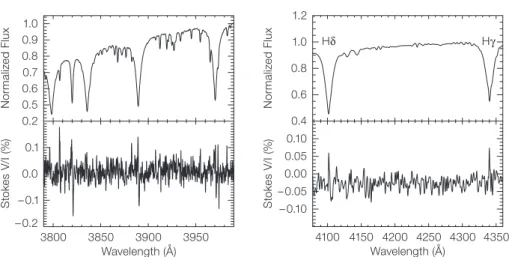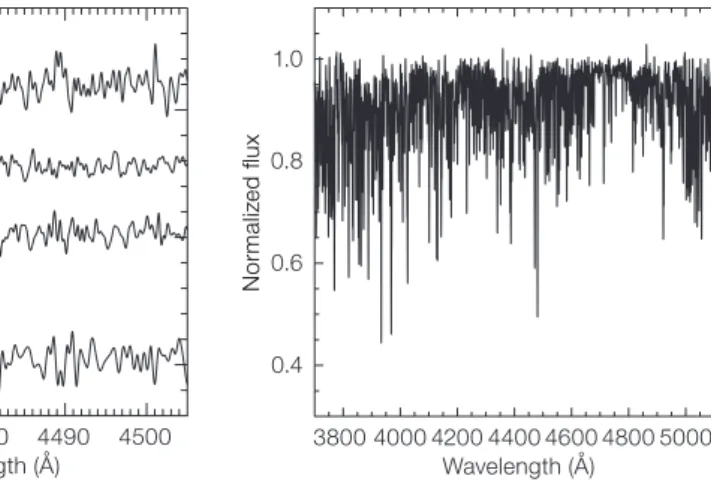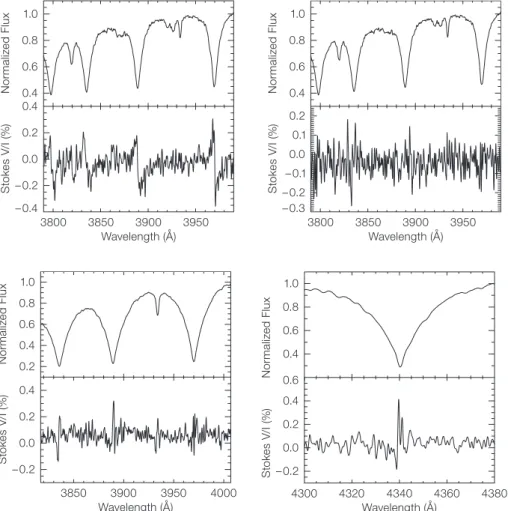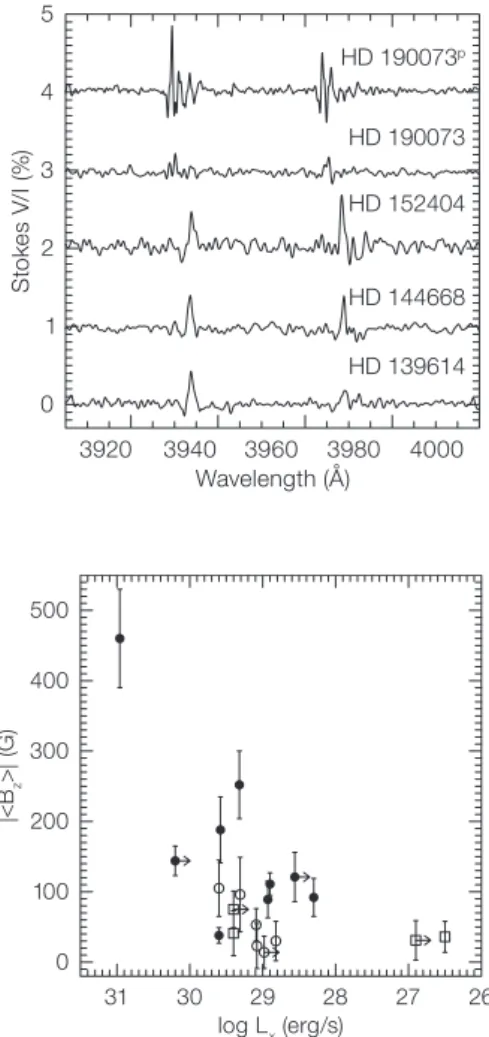Swetlana Hubrig1 2 Markus Schöller1 Maryline Briquet3 Peter De Cat4 Thierry Morel5 Donald Kurtz6 Vladimir Elkin6 Beate Stelzer7 Roald Schnerr8 Carol Grady9 Mikhail Pogodin10 11 Oliver Schütz1 Michel Curé12 Ruslan Yudin10 11 Gautier Mathys1 1 ESO
2 Astrophysikalisches Institut Potsdam, Germany
3 Instituut voor Sterrenkunde, Katholieke Universiteit Leuven, Belgium
4 Koninklijke Sterrenwacht van België, Brussel, Belgium
5 Institut d’Astrophysique et de Géophy-sique, Université de Liège, Belgium 6 Centre for Astrophysics, University of
Central Lancashire, Preston, UK 7 INAF-Osservatorio Astronomico di
Palermo, Italy
8 Institute for Solar Physics, Royal Swedish Academy of Sciences, Stockholm, Sweden
9 Eureka Scientific, Oakland, USA 10 Pulkovo Observatory, Saint-
Petersburg, Russia
11 Isaac Newton Institute of Chile, Saint-Petersburg Branch, Russia
12 Departamento de Física y Astronomía, Universidad de Valparaíso, Chile
We summarise the results of our recent magnetic field studies in upper main-sequence stars, which have exploited the spectropolarimetric capability of FORS1 at the VLT extensively.
Introduction
Currently, most stellar magnetic field observations are carried out using three spectropolarimeters. In the northern hemisphere, the high resolution spectro-polarimeter ESPaDOnS is installed at the 3.6-metre Canada France Hawaii Tel-escope (CFHT) on Mauna Kea and its
twin NARVAL at the 2-metre Telescope Bernard Lyot on Pic du Midi. ESPaDOnS and NARVAL can obtain linear and cir cular polarisation spectra at a resolu-tion of about 65000. In the southern hemisphere, the visual and near UV FOcal Reducer and low dispersion Spectro-graph, FORS1, at UT2/Kueyen of the VLT offers a spectropolarimetric mode with a resolution of up to 4000. The two smaller telescopes, in particular the Tele-scope Bernard Lyot, dedicate significant amounts of observing time to magnetic studies by the French and Canadian com-munities, making long-term magnetic monitoring and magnetic surveys of cer-tain types of stars possible. However only a few programmes have been devoted to the study of stellar magnetic fields with FORS1 in recent years, on account of the high demand for observing time with all instruments installed on Kueyen. One of the biggest advantages of using FORS1 at an 8-metre telescope is the large collecting area, giving high S/N polarimetric spectra of relatively faint stars, down to magnitudes 12–13. Further, due to the use of Balmer series lines for the measurements of stellar magnetic fields in the blue spectral region, ob -served with grisms 600B or 1200B, fast rotators with v sin i up to 300 km/s can be studied. The technique for measuring stellar magnetic fields with FORS1 in polarimetric mode was discussed by Bagnulo et al. (2001) eight years ago, when the first measurement of the well known strongly magnetic chemically peculiar A-type star HD 94660 was dis-cussed in detail.
The measurement of magnetic fields makes use of the presence of circular polarisation in spectral lines, allowing lon-gitudinal magnetic field, which is the component of the magnetic field along the line of sight, averaged over the stellar disc, to be determined. Since no ESO pipeline for the FORS1 spectro-polarimetric mode exists, the spectrum extraction is performed using a pipeline written by Thomas Szeifert. The software for measuring the magnetic field strength was developed by us. In the following we describe our magnetic field discover-ies achieved with FORS1 in recent years.
New magnetic chemically peculiar stars The magnetic chemically peculiar stars with spectral classes A and B (Ap and Bp stars) are presently the best-studied stars in terms of magnetic field strength and magnetic field geometry. Contrary to the case of solar-like stars, their mag-netic fields are dominated by large spatial scales and remain unchanged on yearly timescales. Braithwaite & Spruit (2004) confirmed, through simulations using 3D numerical hydrodynamics, the existence of stable magneto-hydrodynamic config-urations that might account for long-lived, ordered magnetic fields in these types of stars.
During 2002–2004, our first survey of a sample of more than 150 Ap and Bp stars, including rapidly oscillating Ap stars (Hubrig et al., 2006a) confirmed that low resolution spectropolarimetry of hydrogen Balmer lines obtained with FORS1 rep-resents a powerful diagnostic tool for the detection of stellar magnetic fields. We first discovered magnetic fields in 63 Ap and Bp stars in this survey. Some of these stars were used for a re-discussion of the evolutionary state of upper main-sequence magnetic stars with accurate Hipparcos parallaxes. These new obser-vations confirmed our previous finding that magnetic stars of mass M < 3 M0 are concentrated towards the centre of the main-sequence band, whereas stars with masses M > 3 M0 seem to be con-centrated closer to the zero-age main-sequence (Hubrig et al., 2000; 2007a). In the course of this study we discovered an extreme magnetic Ap star, HD 154708 (= CD –57°6753), which has the strong-est longitudinal magnetic field ever detected in a rapidly oscillating Ap (roAp) star, with a mean magnetic field modulus < B > = 24.5 ± 1.0 kG (Hubrig et al., 2005). This magnetic field is about a fac-tor of three stronger than that of
HD 166473, < B > ≈ 5.5–9.0 kG, the roAp star with the second strongest magnetic field. In Figure 1 we present recent FORS1 measurements of the former star over three months in 2008 used to determine the rotation period of Prot = 5.367 ± 0.020 days. HD 154708 is the first star observed with FORS1 with a sufficiently uniform phase coverage to establish its magnetic
period (Hubrig et al., 2009, submitted). Note that the size of the error bars is compa rable to the size of the dots repre-senting the individual measurements. The measu rement with the largest sigma (< Bz > = 6.326 ± 0.059 kG) was obtained in weather conditions classified as “thick clouds”, where the guide star was fre-quently lost and thus was repeated by the service observer a couple of nights later.
O stars, pulsating B-type stars and early-type emission line stars
Massive stars usually end their evolution with a final supernova explosion, pro-ducing neutron stars or black holes. The initial masses of these stars range from 9–100 M0 or more, which correspond to spectral types earlier than about B2. The presence of magnetic fields in massive stars has been suspected for a long time. The discovery of these mag-netic fields would explain a wide range of well-documented enigmatic phenomena, in particular cyclical wind variability, Hα emission variations, chemical peculi-arity, narrow X-ray emission lines and non-thermal radio/X-ray emission. Direct meas urements of the magnetic field strength in massive stars using
spectro-polarimetry to determine the Zeeman splitting of the spectral lines are difficult, since only a few spectral lines are avail-able for these measurements and these are usually strongly broadened by rapid rotation.
For a couple of years, the O6Vpe star θ1 Ori C remained the only massive O-type star with a detected magnetic field (Donati et al., 2002). To examine the potential of FORS1 for the measurements of magnetic fields in massive stars, in 2007 we obtained 12 observations of θ1 Ori C distributed over the rotational period of 15.4 days and compared them with previous measurements obtained with high resolution spectropolarimeters. The FORS1 measurements were suf ficiently accurate to show a smooth sinusoidal curve in spite of a phase
gap between 0.60 and 0.88, but with somewhat dif ferent values of the mag-netic field strength compared to previous measurements obtained with Musicos, ESPaDOnS and NARVAL (Hubrig et al., 2008). Unlike FORS1 measurements, the high resolution spectropolarimeters usually do not employ measurements on hydrogen lines and thus different val-ues of the magnetic field strength may be expected.
Recently we acquired 38 new spectro-polarimetric observations of 13 O-type stars with FORS1, which led to magnetic field detections in an additional four massive O-type stars. As the lower number hydrogen lines in massive stars generally show variable emission, the measurements of magnetic fields are usually performed in two ways: using only the absorption hydrogen Balmer lines or using the entire spectrum including all available absorption lines of hydrogen, Hei, Heii, Ciii, Civ, Nii, Niii and Oiii. As an
important step, before the assessment of the longitudinal magnetic field, we exclude all spectral features not belong-ing to the stellar photospheres of the studied stars: telluric and interstellar fea-tures, CCD defects, emission lines and lines with strong P Cygni profiles. This was the first time that magnetic field strengths were determined for such a large sample of O-type stars, with an accuracy of a few tens of Gauss, comparable to the errors obtained with high resolution spec-tropolarimeters. No magnetic fields stronger than 300 G were detected in the studied sample, suggesting that large-Astronomical Science
Figure 1. Phase diagram for the magnetic field measure-ments of the strongly magnetic star HD 154708; using hydro-gen and metal lines the best frequency is 0.1863 d-1, Prot = 5.367 days. 0 0.5 1 Phase 8.5 8 7.5 7 6 6.5 < Bz > (k G )
Figure 2. Left: Stokes I and V spectra of the β Cephei star ξ1 CMa in the blue spectral region
around high number Balmer lines. Right: Stokes I and V spectra of the Be star ο Aqr in the region including Hδ and Hγ lines.
0.5 0.6 0.7 0.8 0.9 1.0 3800 3850 3900 3950 Wavelength (Å) – 0.2 – 0.1 0.0 0.1 0.2 S to ke s V/ I ( % ) N or m al iz ed F lu x 0.4 0.6 0.8 1.0 1.2 4100 4150 4200 4250 4300 4350 Wavelength (Å) – 0.10 – 0.05 0.00 0.05 0.10 S to ke s V/ I ( % ) N or m al iz ed F lu x Hδ Hγ
Balmer emission, had been a puzzle for a long time with respect to the pres-ence of magnetic fields in their atmos-pheres. Only a very few stars of this type with very weak magnetic fields had been detected before we started our surveys of magnetic fields in B-type stars in 2004. Out of the 13 β Cephei stars studied to date with FORS1, four stars, δ Cet, ξ1 CMa, 15 CMa and V1449 Aql, possess weak magnetic fields of the order of a few hundred Gauss. The star ξ1 CMa is the record holder with the largest mean longitudinal magnetic field of the order of 300–400 G (Hubrig et al., 2006b; 2009). In Figure 2 (left) we present Stokes I and V spectra of ξ1 CMa in the blue spectral region around the high Balmer series lines. Distinct Zeeman features, which are indicators of the presence of a magnetic field in this star, are easily detected at the wavelengths corresponding to the posi-tions of strong spectral lines in the Stokes I spectrum. Figure 2 demonstrates the great advantage of using the blue- optimised EEV2 CCD of FORS1 for mag-netic field measurements in the blue spectral region to cover all H Balmer lines from Hβ to the Balmer jump. Roughly half
The magnetic fields of Be stars appear to be very weak, generally of the order of 100 G and less. Furthermore, our time-resolved magnetic field measurements of a few classical Be stars indicate that some of them may display a magnetic cyclic variability on timescales of tens of minutes. In Figure 2 (right) we present Stokes I and V spectra of the typical Be star ο Aqr in the region including Hδ and Hγ lines with a measured longitudinal magnetic field < Bz > = +104 ± 33 G. Another emission line star, υ Sgr, is a magnetic variable star, probably on a few months timescale with a maximum longi-tudinal magnetic field < Bz > = +38 ± 10 G (see Figure 3). The evolutionary status for this star is not obvious as it is a single-line spectroscopic binary system currently observed in the initial rapid phase of mass exchange between the two components (Koubský et al., 2006). The star is hydro-gen-poor and the observed spectrum is extremely line-rich (see Figure 3). Future monitoring of its magnetic field over a few months with a high resolution spectro-polarimeter would be of extreme interest to understand the role of the magnetic
of the possible origin of such magnetic fields. One important step towards answering this question would be to con-duct observations of members of open clusters and associations of different ages. To date, we have studied the pres-ence of magnetic fields only in members of the young open cluster NGC 3766 in the Carina spiral arm, known for its high content of early-B type stars, with very surprising results. Along with a strong magnetic field detected in a He-peculiar star, weak magnetic fields have been detected in a few normal B-type stars and in a few Be stars (Hubrig et al., in preparation). In Figure 4 we present the observed Stokes I and V profiles of the He-peculiar member of this cluster and of another cluster member that was classified as a potential Be star by Shobbrook (1985) with longitudinal mag-netic fields of < Bz > = +1559 ± 38 G and < Bz > = –194 ± 62 G, respectively. Obviously, to understand the role of mag-netic fields in massive stars, future obser-vations are urgently needed to determine the fraction of magnetic massive stars and the distribution of their typical field
Figure 3. Left: Observed Stokes V spectra of the emission line star υ Sgr over two years in the vicinity of Mgii 4481. Right: Normalised FORS1 Stokes I
spectrum of υ Sgr. MJD 53519.91 MJD 54333.02 MJD 54343.10 MJD 54361.08 1.0 4460 4470 4480 4490 4500 Wavelength (Å) 0.0 0.5 S to ke s V/ I ( % ) 1.0 3800 4000 4200 4400 4600 4800 5000 Wavelength (Å) 0.4 0.8 0.6 N or m al iz ed fl ux
strengths. Further, we note that no physi-cal properties are known that define these particular classes of stars as non-magnetic. It seems to be appropriate to admit that the inability to detect mag-netic fields in massive stars in previous studies could be related to the weakness of these fields, which can, in some stars, be as little as only a few tens of Gauss (e.g., Bouret et al., 2008).
Herbig Ae/Be stars — resolving an enigma
In our recent studies of Herbig Ae/Be stars we sought to expand the sample of stars with measured magnetic fields to determine whether magnetic field proper-ties in these stars are correlated with other observed properties such as mass-accretion rate, disc inclination, compan-ions, silicates, PAHs, or show a correlation
with age and X-ray emission as expected from the decay of a remnant dynamo (Hubrig et al., 2009, A&A submitted). Dur-ing our two-night observDur-ing run in May 2008 we were able to obtain circular polarisation data for 23 Herbig Ae/Be stars and six debris disc stars. No defi-nite detection was achieved for stars with debris discs, whereas for Herbig Ae/Be stars 12 magnetic field detections were achieved. One of the Herbig Ae stars, HD 101412, showed the largest magnetic field strength ever measured in intermediate mass pre-main-sequence stars with < Bz > = –454 ± 42 G, confirm-ing the previous FORS1 detection by Wade et al. (2007). The Stokes I and V spectra of this star are shown in Figure 5. Strong distinct Zeeman features at the position of the Caii H and K lines
detected in four other Herbig Ae/Be stars are presented in Figure 6. As we already
reported in our earlier studies (Hubrig et al., 2004, 2007b) these lines are very likely formed at the base of the stellar wind, as well as in the accretion gaseous flow and frequently display multi- component complex structures in both the Stokes V and the Stokes I spectra. Observations of the disc properties of intermediate mass Herbig Ae stars suggest a close parallel to T Tauri stars, revealing the same size range of the discs, similar optical surface brightness and structure. It is quite possible that magnetic fields play a crucial role in con-trolling accretion onto, and winds from, Herbig Ae stars, similar to the magnet-ospheric accretion observed in T Tauri stars. Using our sample of Herbig Ae stars with masses of 3 M0 or less, we searched for a link with other stellar parameters to put preliminary constraints on the mechanism responsible for Astronomical Science
Figure 5. Stokes I and V spectra of the Herbig Ae/Be star HD 101412 with the largest detected magnetic field. Left: Zeeman features in H9, H8, Caii H and K
and Hε profiles. Right: Stokes I and V spectra in the vicinity of the Hγ line.
Wavelength (Å) S to ke s V/ I ( % ) N or m al iz ed F lu x 0.2 0.4 0.6 0.8 1.0 3850 3900 3950 4000 – 0.2 0.0 0.2 0.4 Wavelength (Å) S to ke s V/ I ( % ) N or m al iz ed F lu x 0.4 0.6 0.8 1.0 4300 4320 4340 4360 4380 – 0.2 0.0 0.2 0.4 0.6 0.4 0.6 0.8 1.0 3800 3850 3900 3950 Wavelength (Å) – 0.4 – 0.2 0.0 0.2 0.4 S to ke s V/ I ( % ) N or m al iz ed F lu x 0.4 0.6 0.8 1.0 3800 3850 3900 3950 Wavelength (Å) – 0.3 – 0.1 – 0.2 0.0 0.1 0.2 S to ke s V/ I ( % ) N or m al iz ed F lu x
Figure 4. Left: Stokes I and V spectra in the blue spectral region around high number Balmer lines for an He-peculiar member of the young open clus-ter NGC 3766. Right: Stokes I and V spectra around high number Balmer lines for a candidate Be star belonging to the young open cluster NGC 3766.
magnetospheric activity. For the first time we established preliminary trends between magnetic field strength, mass-accretion rate, X-ray emission and age. We find that the range of observed mag-netic field values is in agreement with the expectations from magnetospheric accre-tion models giving support for dipole- like field geometries. Both the magnetic field strength and the X-ray emission show hints of a decline with age in the range of 2–14 Myrs probed by our sample, supporting a dynamo mechanism that
decays with age. In Figure 7 (left), we present the strength of the magnetic field plotted versus log LX. It is noteworthy that we find a hint of an increase in the mag-netic field strength with the level of the X-ray emission, which suggests that a dynamo mechanism may be responsible for the coronal activity in Herbig Ae stars. There is obviously a trend showing that stronger magnetic fields tend to be found in younger Herbig Ae stars and that mag-netic fields become very weak at the end
In summary, using FORS1 spectro-polarimetric observations, considerable progress has been made over the last eight years in studies of the presence of magnetic fields in upper main-se quence stars. These results are providing sev- eral new clues, but are also posing a number of new open questions requiring future spectropolarimetric studies. Currently FORS1 in spectropolarimetric mode is the only facility regularly used for observations of circular and linear polarisation by the ESO community. Since FORS1 was decommisioned in P83, the polarimetric capability has been moved to FORS2 with the blue optimised EEV2 CCD available exclusively in visitor mode. We hope that the spectroscopic capa-bilities of FORS2 will be used in the future as intensively and successfully as they were used on FORS1 in the past.
References
Bagnulo, S. et al. 2001, The Messenger, 104, 32 Bouret, J.-C. et al. 2008, MNRAS, 389, 75 Braithwaite, J. & Spruit, H. C. 2004, Nature, 431, 819 Brown, J. C. et al. 2004, MNRAS, 352, 1061 Donati, J.-F. et al. 2002, MNRAS, 333, 55 Hubrig, S., North, P. & Mathys, G. 2000, ApJ, 539, 352
Hubrig, S., Schöller, M. & Yudin, R. V. 2004, A&A, 428, L1
Hubrig, S. et al. 2005, A&A, 440, L37 Hubrig, S. et al. 2006a, AN, 327, 289 Hubrig, S. et al. 2006b, MNRAS, 369, L61 Hubrig, S., North, P. & Schöller, M. 2007a, AN, 328, 475
Hubrig, S. et al. 2007b, A&A, 463, 1039 Hubrig, S. et al. 2008, A&A, 490, 793 Hubrig, S. et al. 2009, AN, in press Koubský, P. et al. 2006, A&A, 459, 849 Shobbrook, R. R. 1985, MNRAS, 212, 591 Wade, G. A. et al. 2007, MNRAS, 376, 1145
3920 3940 3960 3980 4000
Wavelength (Å) 0
HD 139614
Figure 7. Left: The strength of the longitudinal mag-netic field plotted against the X-ray luminosity. Right: The strength of the longitudinal magnetic field as a function of age. Filled circles denote Herbig Ae stars with a 3-σ magnetic field detection, while open circles denote Herbig Ae stars with a lower σ. Squares denote stars with debris discs, of which none has a 3-σ magnetic field detection.
400 500 31 30 29 28 27 26 log Lx (erg/s) 100 200 0 300 |< Bz >| (G ) 400 500 0 2 4 6 8 10 12 14 Age (Myr) 100 200 0 300 |< Bz >| (G )



